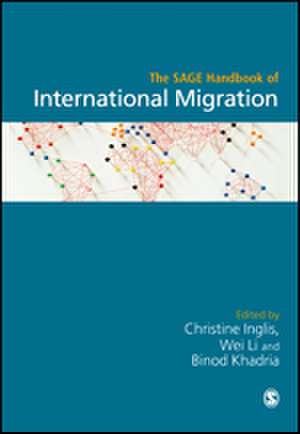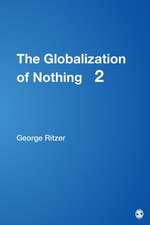The SAGE Handbook of International Migration
Editat de Christine Inglis, Wei Li, Binod Khadriaen Limba Engleză Hardback – 18 noi 2019
- Part 1: Disciplinary Perspectives on Migration
- Part 2: Historical and Contemporary Flows of Migrants
- Part 3: Theory, Policy and the Factors Affecting Incorporation
- Part 4: National and Global Policy Challenges in Migration
Preț: 1121.03 lei
Preț vechi: 1535.67 lei
-27% Nou
Puncte Express: 1682
Preț estimativ în valută:
214.51€ • 233.74$ • 180.76£
214.51€ • 233.74$ • 180.76£
Carte tipărită la comandă
Livrare economică 23 aprilie-07 mai
Preluare comenzi: 021 569.72.76
Specificații
ISBN-13: 9781412961752
ISBN-10: 1412961750
Pagini: 688
Dimensiuni: 184 x 246 x 40 mm
Greutate: 1.29 kg
Ediția:First Edition
Editura: SAGE Publications
Colecția Sage Publications Ltd
Locul publicării:London, United Kingdom
ISBN-10: 1412961750
Pagini: 688
Dimensiuni: 184 x 246 x 40 mm
Greutate: 1.29 kg
Ediția:First Edition
Editura: SAGE Publications
Colecția Sage Publications Ltd
Locul publicării:London, United Kingdom
Recenzii
An exciting and rich treasure trove of articles by many leading migration scholars, providing extraordinarily broad coverage of topics on theory and policy within a truly multidisciplinary and international framework. The Handbook will be a valuable resource for students and scholars alike.
Scholars, students, and policy makers will discover a comprehensive overview of research and theories on international migration in this excellent collection of essays edited by Christine Inglis, Wei Li and Binod Khadria. A distinctive contribution of this publication is its multidisciplinary approach that surveys the state of knowledge on the forces that drive international movements and also on what happens to migrants in their destinations. The volume includes chapters on historical and contemporary migration covering almost every world region, written by a diverse range of scholars and researchers from the East and South as well as from the West and North. It will be an essential reference for many years to come.
This handbook of International Migration outlines in 42 chapters the state-of-the-art of migration studies in the widest sense, including settlement processes of migrants and policies that try to “manage” these processes. Its scope is global and its focus is on recent movements across borders. The line-up of authors is impressive: some 50 experts, representing all relevant disciplines are chosen to write on their specific topics. It is this combination of the broad delineation of the field of migration and settlement, the global coverage of these topics and the diversity of authors that makes it a recommendable Handbook.
The SAGE Handbook of International Migration is an exceptional addition to the growing list of references on one of the mega-trends of our times. The various handbooks, including this one, have different offerings: some are references on migration in general, others are specific to international migration, and some focus on particular aspects (e.g., migration data, or migration and health, and economics of international migration, among others). The SAGE Handbook is a rich volume covering four themes: interdisciplinary perspectives of migration; historical and contemporary flows of migrants; theory, policy and the factors affecting incorporation; and national and global policy challenges in migration. The contributions of the different disciplines to migration studies, the attention to both historical and contemporary flows, the comprehensive geographical scope, and the multi-level analyses spanning from the local to the global make for an insightful and exhaustive compilation of essays on our world in motion.
Scholars, students, and policy makers will discover a comprehensive overview of research and theories on international migration in this excellent collection of essays edited by Christine Inglis, Wei Li and Binod Khadria. A distinctive contribution of this publication is its multidisciplinary approach that surveys the state of knowledge on the forces that drive international movements and also on what happens to migrants in their destinations. The volume includes chapters on historical and contemporary migration covering almost every world region, written by a diverse range of scholars and researchers from the East and South as well as from the West and North. It will be an essential reference for many years to come.
This handbook of International Migration outlines in 42 chapters the state-of-the-art of migration studies in the widest sense, including settlement processes of migrants and policies that try to “manage” these processes. Its scope is global and its focus is on recent movements across borders. The line-up of authors is impressive: some 50 experts, representing all relevant disciplines are chosen to write on their specific topics. It is this combination of the broad delineation of the field of migration and settlement, the global coverage of these topics and the diversity of authors that makes it a recommendable Handbook.
The SAGE Handbook of International Migration is an exceptional addition to the growing list of references on one of the mega-trends of our times. The various handbooks, including this one, have different offerings: some are references on migration in general, others are specific to international migration, and some focus on particular aspects (e.g., migration data, or migration and health, and economics of international migration, among others). The SAGE Handbook is a rich volume covering four themes: interdisciplinary perspectives of migration; historical and contemporary flows of migrants; theory, policy and the factors affecting incorporation; and national and global policy challenges in migration. The contributions of the different disciplines to migration studies, the attention to both historical and contemporary flows, the comprehensive geographical scope, and the multi-level analyses spanning from the local to the global make for an insightful and exhaustive compilation of essays on our world in motion.
Cuprins
Chapter 1: Introduction: Understanding Migration - Christine Inglis and Wei Li
Part 1: Inter-Disciplinary Perspectives on Migration
Chapter 2: Part 1 Introduction: Disciplinary Perspectives on International Migration - Christine Inglis
Chapter 3: Demography - Mary M. Kritz
Chapter 4: Development Studies and Migration - Habibul Khondker
Chapter 5: Economics and Migration - Gudrun Biffl
Chapter 6: Education, Citizenship and International Migration - James A. Banks
Chapter 7: Environmental Studies and Migration - Usha Ziegelmayer, Johannes Herbeck & Felicitas Hillmann
Chapter 8: Geography and Migration - Emily Skop
Chapter 9: History - Dirk Hoerder
Chapter 10: Migration, Linguistics and Sociolinguistics - Sue Wright
Chapter 11: Migration and the Policy Sciences - Peter Scholten
Part 2: Historical and Contemporary Flows of Migrants
Chapter 12: Part 2 Introduction: International Migration Flows - Wei Li
Chapter 13: Historical Patterns of Migration Prior to the Mid-20th Century - Dirk Hoerder
Chapter 14: Rethinking Global Migration Flows - Phillip Martin
Chapter 15: Gender and the Feminisation of Migration - Eleonore Kofman
Chapter 16: Regional and Intercontinental Migration in Sub-Saharan Africa - Aderanti Adepoju
Chapter 17: Middle East and North Africa (MENA) - Mohammed Charef
Chapter 18: South Asian Migration - Binod Khadria
Chapter 19: International Migration Trends and Policies in Southeast Asia - Sakkarin Niyomsilpa
Chapter 20: International Migration in East Asia - Huiyao Wang, Lu Miao, Jingmin Yang, & Yicheng Jiang
Chapter 21: Australasia and the Pacific Islands - Richard Bedford
Chapter 22: Migrations in South America - Marcela Cerrutti & Emilio Parrado
Chapter 23: Contemporary Migration Patterns in North and Central America - Claudia Masferrer, Silvia E. Giorguli-Saucedo, Víctor M. García-Guerrero
Chapter 24: European Migration Transition in the Context of Post-enlargement Migration from and into Central and Eastern Europe - Agata Gorny & Pawel Kaczmarczyk
Chapter 25: International Migration Trends and Policies in Russia and Eurasia - Sergey V. Ryazantsev
Part 3: Theory, Policy and the Factors Affecting Incorporation
Chapter 26: Part 3 Introduction: Theory, Policy and the Factors Affecting Incorporation - Christine Inglis
Chapter 27: Assimilation - Richard Alba & Victor Nee
Chapter 28: Multiculturalism and Immigration - Peter Kivisto
Chapter 29: Transnationalism - Derya Özkul
Chapter 30: Migrant Entrepreneurship and Transnational Links - Jan Rath, Giacomo Solano, & Veronique Schultjens
Chapter 31: Inequality and the Structure of Educational Opportunity and Institutions - Anthony Heath & Laurence Lessard-Phillips
Chapter 32: Language and Incorporation - Sue Wright & Claudia Viggiano
Chapter 33: Spatial Concentrations and Ghettos - David Kaplan
Chapter 34: The Role of Religion in Migrant Incorporation - Tuomas Martikainen
Chapter 35: Citizenship - Anna Tsalapatanis
Chapter 36: Racism and the Age of Super Diversity - John Solomos
Part 4: National and Global Policy Challenges in Migration
Chapter 37: Part 4 Introduction: National and Global Policy Challenges in Migration - Binod Khadaria
Chapter 38: Remittances and Migrants. Altruism, Insurance, Investment and Development - John Connell & Richard Brown
Chapter 39: Migration and State Concerns about the Emigration & Welfare of their Citizens - Jean-Michel Lafleur
Chapter 40: Trends in International, National and Local Policies on Migrant Entry and Integration - Howard Duncan
Chapter 41: Refugees and Asylum Seekers - Kathleen Newland & Susan Fratzke
Chapter 42: Migration and the State's Focus on Human Trafficking as a Security Issue - Heli Askola
Part 1: Inter-Disciplinary Perspectives on Migration
Chapter 2: Part 1 Introduction: Disciplinary Perspectives on International Migration - Christine Inglis
Chapter 3: Demography - Mary M. Kritz
Chapter 4: Development Studies and Migration - Habibul Khondker
Chapter 5: Economics and Migration - Gudrun Biffl
Chapter 6: Education, Citizenship and International Migration - James A. Banks
Chapter 7: Environmental Studies and Migration - Usha Ziegelmayer, Johannes Herbeck & Felicitas Hillmann
Chapter 8: Geography and Migration - Emily Skop
Chapter 9: History - Dirk Hoerder
Chapter 10: Migration, Linguistics and Sociolinguistics - Sue Wright
Chapter 11: Migration and the Policy Sciences - Peter Scholten
Part 2: Historical and Contemporary Flows of Migrants
Chapter 12: Part 2 Introduction: International Migration Flows - Wei Li
Chapter 13: Historical Patterns of Migration Prior to the Mid-20th Century - Dirk Hoerder
Chapter 14: Rethinking Global Migration Flows - Phillip Martin
Chapter 15: Gender and the Feminisation of Migration - Eleonore Kofman
Chapter 16: Regional and Intercontinental Migration in Sub-Saharan Africa - Aderanti Adepoju
Chapter 17: Middle East and North Africa (MENA) - Mohammed Charef
Chapter 18: South Asian Migration - Binod Khadria
Chapter 19: International Migration Trends and Policies in Southeast Asia - Sakkarin Niyomsilpa
Chapter 20: International Migration in East Asia - Huiyao Wang, Lu Miao, Jingmin Yang, & Yicheng Jiang
Chapter 21: Australasia and the Pacific Islands - Richard Bedford
Chapter 22: Migrations in South America - Marcela Cerrutti & Emilio Parrado
Chapter 23: Contemporary Migration Patterns in North and Central America - Claudia Masferrer, Silvia E. Giorguli-Saucedo, Víctor M. García-Guerrero
Chapter 24: European Migration Transition in the Context of Post-enlargement Migration from and into Central and Eastern Europe - Agata Gorny & Pawel Kaczmarczyk
Chapter 25: International Migration Trends and Policies in Russia and Eurasia - Sergey V. Ryazantsev
Part 3: Theory, Policy and the Factors Affecting Incorporation
Chapter 26: Part 3 Introduction: Theory, Policy and the Factors Affecting Incorporation - Christine Inglis
Chapter 27: Assimilation - Richard Alba & Victor Nee
Chapter 28: Multiculturalism and Immigration - Peter Kivisto
Chapter 29: Transnationalism - Derya Özkul
Chapter 30: Migrant Entrepreneurship and Transnational Links - Jan Rath, Giacomo Solano, & Veronique Schultjens
Chapter 31: Inequality and the Structure of Educational Opportunity and Institutions - Anthony Heath & Laurence Lessard-Phillips
Chapter 32: Language and Incorporation - Sue Wright & Claudia Viggiano
Chapter 33: Spatial Concentrations and Ghettos - David Kaplan
Chapter 34: The Role of Religion in Migrant Incorporation - Tuomas Martikainen
Chapter 35: Citizenship - Anna Tsalapatanis
Chapter 36: Racism and the Age of Super Diversity - John Solomos
Part 4: National and Global Policy Challenges in Migration
Chapter 37: Part 4 Introduction: National and Global Policy Challenges in Migration - Binod Khadaria
Chapter 38: Remittances and Migrants. Altruism, Insurance, Investment and Development - John Connell & Richard Brown
Chapter 39: Migration and State Concerns about the Emigration & Welfare of their Citizens - Jean-Michel Lafleur
Chapter 40: Trends in International, National and Local Policies on Migrant Entry and Integration - Howard Duncan
Chapter 41: Refugees and Asylum Seekers - Kathleen Newland & Susan Fratzke
Chapter 42: Migration and the State's Focus on Human Trafficking as a Security Issue - Heli Askola
Descriere
Provides an authoritative and informed analysis of key issues in international migration, including its crucial significance far beyond the more traditional questions of immigrant settlement and incorporation in particular countries.



















